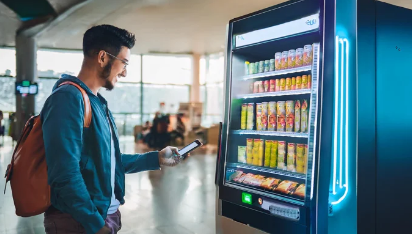Vending machines have come a long way since their inception in ancient Greece. From simple dispensers of holy water to sophisticated retail platforms, vending machines have evolved significantly over the centuries. Today, vending machines can be found in almost every corner of the globe, dispensing a wide range of products, from snacks and drinks to umbrellas and live crabs.
In this article, we will explore the evolution of vending machines, from their early beginnings to the modern-day marvels that are changing the retail landscape.
The Early Years: Simple Dispensers and Honesty Boxes
The first vending machines were simple dispensers that relied on gravity to release products. These early machines were often used to dispense holy water, postcards, and other small items. In the late 19th century, honesty boxes became popular in the United States. These boxes allowed customers to select a product and then deposit the required amount of money into a slot.
The Advent of Coin-Operated Machines
The early 20th century saw the introduction of coin-operated vending machines. These machines used a combination of levers, pulleys, and weights to dispense products in exchange for coins. Coin-operated machines quickly became popular, and by the mid-20th century, they could be found in offices, schools, and public spaces across the United States.
The Rise of Electronic Vending Machines
The 1980s saw the introduction of electronic vending machines, which used microprocessors and electronic payment systems to dispense products. These machines were more efficient and reliable than their mechanical counterparts and quickly became popular. The 1990s saw the introduction of cashless payment systems, which allowed customers to pay using credit or debit cards.

The Modern Era: Sophisticated Retail Platforms
Today, vending machines are more sophisticated than ever. Modern vending machines use advanced technologies like touch screens, cashless payment systems, and remote monitoring to provide a seamless and convenient shopping experience. Many modern vending machines also offer healthy and sustainable options, such as fresh produce, nuts, and seeds.Also Read>>>>
Innovative Vending Machines Around the World
From Japan to the United States, vending machines are being used in innovative and creative ways. In Japan, vending machines dispense everything from live crabs to umbrellas, while in the United States, vending machines are being used to provide healthy snacks and fresh produce to underserved communities.
The Future of Vending Machines
As technology continues to evolve, it’s likely that vending machines will become even more sophisticated and integrated into our daily lives. Some potential trends and innovations on the horizon include:
- Artificial Intelligence (AI): AI-powered vending machines that can learn customer preferences and offer personalized recommendations.
- Internet of Things (IoT): Vending machines that are connected to the IoT, enabling real-time monitoring, inventory management, and predictive maintenance.
- Cashless Payments: Vending machines that accept a wide range of cashless payment options, including mobile payments, credit cards, and cryptocurrencies.
- Sustainable and Eco-Friendly Options: Vending machines that offer sustainable and eco-friendly options, such as reusable water bottles, eco-friendly cleaning products, and locally sourced snacks.
Conclusion
The evolution of vending machines has been a remarkable journey, from simple dispensers to sophisticated retail platforms. As technology continues to advance, it’s likely that vending machines will become even more integrated into our daily lives, offering convenient, sustainable, and personalized shopping experiences. Whether you’re a consumer, a business owner, or simply a curious observer, the future of vending machines is certainly worth watching.
Timeline of Vending Machine Evolution
- 215 BC: The first vending machine is invented by Hero of Alexandria, dispensing holy water.
- Late 19th century: Honesty boxes become popular in the United States.
- Early 20th century: Coin-operated vending machines are introduced.
- 1980s: Electronic vending machines are introduced, using microprocessors and electronic payment systems.
- 1990s: Cashless payment systems are introduced, allowing customers to pay using credit or debit cards.
- 2000s: Modern vending machines begin to offer healthy and sustainable options, such as fresh produce and locally sourced snacks.
- 2010s: Vending machines become increasingly connected to the IoT, enabling real-time monitoring, inventory management, and predictive maintenance.